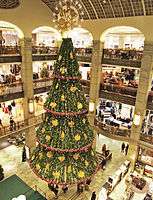Nordiska Kompaniet
 | |
| Private | |
| Industry | Retail |
| Genre | Department Store |
| Founded |
1864 (Gothenburg) 1902 (Stockholm) |
| Founder | Josef Sachs, Karl Ludvig Lundberg |
| Headquarters |
Hamngatan Stockholm, Sweden and Östra Hamngatan Gothenburg, Sweden |
| Products | Quality and luxury goods |
| Owner | Hufvudstaden AB |
| Website |
NK |

Nordiska Kompaniet (colloquially NK, and literally The Nordic Company) is the name of two department stores located in Stockholm and Gothenburg, in Sweden.
The store in Stockholm receives some twelve million visitors annually, with the figure for the store in Gothenburg being about three million and the total number of staff around 1,200. The trademark and the real estate properties in Gothenburg and Stockholm are owned by Hufvudstaden AB, controlled by L E Lundbergföretagen publ (see Fredrik Lundberg).
Swedish Minister of Foreign Affairs Anna Lindh was stabbed in the NK Stockholm store on September 10, 2003. She died the next day after undergoing various unsuccessful operations.
History

The company was founded in Stockholm 1902 through the merger of the two companies K.M. Lundberg and Joseph Leja. The men responsible for the merger were Karl Ludvig Lundberg and Josef Sachs (1872–1949), who wanted to establish a department store that would offer the same level of service as the stores in Paris or London.
On September 21, 1915 the building designed and built especially for the department store was inaugurated on Hamngatan, over the street from the Kungsträdgården park in Stockholm. Ferdinand Boberg, Sweden's leading Art Nouveau architect, designed the building. He was influenced by American department stores, giving the structure an internal load-bearing steel structure and an external facade of granite. Ivar Kreuger's company Kreuger & Toll was responsible for the actual construction of the building.
About 1939 NK installed a circular neon sign with a diameter of 7 meters on Stockholms old central telephone wire tower. The telephone wires were then since some 30 years replaced by underground wiring and the tower rented by the telephone company for commercial purposes. The sign was constructed by L M Ericsson. One side of the sign features the NK logo in green, the other side a clock in red. It weighs four tons and revolves at four rpm. In 1952, the building under the tower was fire-ravaged and the steel tower severely damaged. The neon sign was however not affected by the fire and since 1964 it sits on a custom-designed tower on the NK building's roof, 87 meters above street level.
The building was extended in 1961–63 by architect Hans Asplund along the facade on Regeringsgatan. The extension stands on the former lot of Stockholm's old electric power plant, which remarkably was the first major work by NK's original architect Boberg. In 1971–73 a smaller addition was made by architect Bengt Lindroos when part of the street Smålandsgatan was closed and converted into a building lot. Nordiska Kompaniet (NK) is also the name of the well known design company which produced many popular design commodities in the 20th century.
Acquisition
On March 25, 2009 it was made public that the department store corporation Åhléns, Sweden's leading department store chain would acquire some stores in NK if the deal is approved by the relevant government agency. The price is said to be 440 million Swedish kronor and include 430 employees.[1]
References
External links
Coordinates: 59°19′59″N 18°04′15″E / 59.33304°N 18.07079°E


